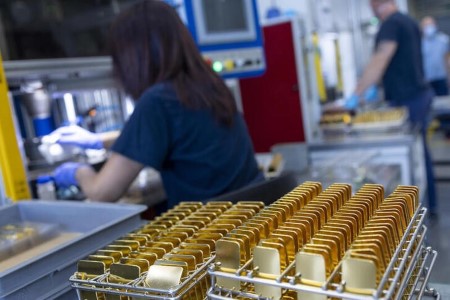




Monthly Economic Update: One for the road
 DOWNLOAD
DOWNLOAD

Inflation Update: Still low, still slow
 DOWNLOAD
DOWNLOAD

Philippines Trade Update: Exports momentum continues
 DOWNLOAD
DOWNLOAD


Gold hits a three-week high as less hawkish Fed dims dollar

July 28 (Reuters) – Gold prices hit a near three-week high on Thursday after US Federal Reserve chair Jerome Powell signalled the central bank could slow the pace of rate hikes in coming months, which weighed on the dollar and Treasury yields.
Spot gold rose 0.7% to USD 1,745.20 per ounce by 0912 GMT, its highest since July 8.
US gold futures rose 1.4% to USD 1,743.70.
“The Fed has turned dovish and although signaled rates may rise, likely it will be at a slower pace so as not to spook Main Street – that has had a negative impact on both the US dollar as well as treasury yields, which have given a lift to gold,” independent analyst Ross Norman said.
The Fed raised its benchmark overnight interest rate by three-quarters of a percentage point on Wednesday in an effort to cool the most intense breakout of inflation since the 1980s.
Powell said another “unusually large” increase in interest rates may be appropriate at the September policy meeting, but the decision will be determined by the incoming economic data between now and then.
Traders have cautiously pared back expectations of further rate rises, as the second quarter GDP figures would provide clarity on the strength of the economy, Norman added.
The dollar index fell 0.2% to a more than three-week low, making greenback-denominated gold less expensive for other currency holders.
“Gold’s relief rally has further to go … gains we’re seeing now are part of a much needed retracement against its bearish trend,” City Index senior market analyst Matt Simpson said.
The next obvious target for gold bulls is USD 1,750, a break above which brings USD 1,770 into focus, Simpson added.
Meanwhile, China’s demand for gold jewellery, bars and coins is expected to fall year-on-year in the second half of 2022, a World Gold Council official said, as lockdowns cut consumer spending.
Elsewhere, spot silver jumped 1.3% to USD 19.38, platinum rose 0.7% to USD 892.36, while palladium added 2.9% to USD 2,090.42.
(Reporting by Arundhati Sarkar in Bengaluru; editing by Carmel Crimmins)
This article originally appeared on reuters.com





 By Reuters
By Reuters